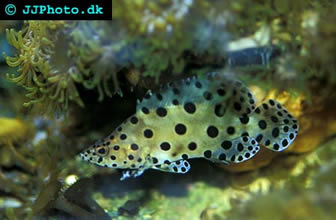Panther Grouper
Cromileptes altivelis
Common name: Panther Grouper, Polka Dot Grouper, Barramundi Cod, Humpback grouper, high-finned grouper
Scientific name: Cromileptes altivelis
Max size: 24 in / 70 cm (rarely larger than 20 in / 50 cm in aquariums)
pH: 8.1-8.4
Salinity: 1.022-1.025
Temperature: 75-78ºF (24-26°C)
The Panther grouper is a stunning fish when young. Large adult specimens often have a little duller coloration with gray areas but are still very beautiful. The body is white and covered with black dots, something that have given the Panther grouper its other common name: Polka dot grouper. The fins are large and graceful (see pictures). Together, the body shape and coloration serves as camouflage.
The Panther grouper is very popular and periodically available; if you have patience it shouldn't be hard to find this species for sale sooner or later. The Panther grouper grows very old (with proper care) and is a very hardy fish. Many consider it the easiest marine fish in the world to care for and adult specimens of this species are often used to help cycle new aquariums.
The Panther grouper grows fast and you should not get it unless you have the ability to house an adult fish. The species is as earlier said very hardy but can despite that due to its size not be recommended to most beginners, since big aquariums sadly enough tend to be unusual among beginners. It can however be recommended to beginners with a large enough tank to house it. The Panther grouper price is usually quite low and you should be able to buy one for $20-30 (2008) in the United States as well as online.
The Panther grouper is a highly predatory fish and will eat anything that it can fit into its mouth. Never keep it with small fish like damsels or clowns as they will end up as food sooner or later. This species is not reef safe as it eats invertebrates, but it can be kept with corals and anemones. If they can't eat it they will leave it alone; the Panther grouper is relatively mild tempered and ignores just about anything that it can't eat. It is much less aggressive than most other grouper species. They can be kept with most fish species that are large enough not to be eaten.
The Panther grouper originates from the eastern Indian Ocean and the western Pacific Ocean and can be found from southern Japan in the north to southern Queensland, Australia in the south. It inhabits a depth of 0–130 ft / 0-40 m and is an appreciated food fish throughout most of is native range.
Panther grouper care and aquarium setup:
The Panther grouper needs a large aquarium do to its large size. Do not keep this species in anything smaller than 100 gallon / 400 L; an even larger aquarium is to be preferred. This is a large predatory fish that produces a lot of waste and good filtration and well circulated water is therefore a must. Try to keep the water quality high and stable even if this fish is very tolerant (in comparison with most other marine fish species) to less than optimal conditions.
In the wild, this species swims along the reefs hunting for pray and you should keep this in mind when decorating your aquarium. They prefer an aquarium with suitable sized hiding places in caves and overhangs as well a lot of open space to swim in. They appreciate a few shaded areas in the tank where they can rest. They have no preferences in regards to bottom substrate. Best kept in a "fish only" or a "fish with live rock setup", since it will devour the mobile invertebrates of a reef aquarium.
Ideal conditions for the Polka dot grouper (Panther grouper) is pH 8.1-8.4, salinity 1.022-1.025, and temperature 75-78ºF (24-26°C).
Feeding Panther Grouper
The Panther or Polka dot grouper is a prefatory fish that will eat anything that fits into its mouth. They are easy to feed and many (but not all) individuals will accept marine pellets after training. This fish should be feed a varied high protein diet. A good diet can be based around frozen shrimp, crab and mussel meat (can be bought in the grocery store) that is complemented with other live and frozen food. They appreciate a feeder fish every now and then but should not be feed only feeders as such a diet won't give them the nutrients they need. They are always hungry.
Breeding Panther Groupers
Next to nothing is known about breeding and sexing the Panther grouper. A very large aquarium is likely needed to breed this species. It has been successfully induced to spawn in captivity one time, but the fry died within a week. It should however be mentioned that this experiment used artificial propagation. (Experiment on artificial propagation of the high-finned grouper, Cromileptes altivelis by Tang et al, 1979.) The eggs are 0.80-0.83 mm in diameter and buoyant.
Grouper Articles:
Peppermint Basslet – Liopropoma rubre

